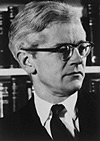
Biol/Chem 5310
Lecture: 9
September 19, 2002
3-Dimensional Structures of Proteins
Globular proteins: Compact, nearly spherical, typical example-enzymes.
Tend to be composed of short elements of secondary structure connected by turns. 3-D structure of many globular proteins has been determined by x-ray crystallography or NMR.
The main limitation of x-ray crystallography is the quality of the crystals. But interpretation of the x-ray diffraction patterns is also difficult.
The size of the protein is the main limitation of structure determination by NMR. Current limits are about 250 amino acids.
As of today there are 18691 Coordinate Entries in the Protein Data Bank / 16823 proteins / 1860 nucleic acids & protein-nucleic acid complexes / 18 carbohydrates . The address is <http://www.rcsb.org/pdb>
The first protein structure determined was by John Kendrew (see also) in late 1950's: myoglobin, an oxygen transport and storage protein found in muscle tissue. It consists of 8 segments of alpha-helix wrapped in an irregular fashion. This result indicated that the structure of proteins would not be as simple as that of DNA. Over the years diverse structures have continued to be discovered, although certain patterns have emerged. Several databases of structural hierarchy exist, such as CATH and SCOP.
Also see the JENA Image Library
Motifs of secondary structure:
b-a-b : parallel b-strands with a right-hand-crossover<LINK> b-hairpin : anti-parallel b-strands with a tight turn.<LINK> a-a : 2 a-helices packed antiparallel in a bundle, or crosswise.<LINK> Greek key: 4 anti-parallel b-strands with "Greek key" connections<LINK> Mouse Control
These motifs are used to form structural domains
4 helix bundle globin fold
Up and down Beta sandwich
a/b barrel open twisted sheet
See Guided Exploration #8: Secondary structures in proteins
Prosthetic groups: Some proteins also contain components that are not amino acids.
Proteins have insides and outsides.
Location of Elements of Secondary structure:
The cores of globular proteins tend to be made from regular secondary structures: a-helices and b-strands. Turns and longer connections tend to be found on the surfaces.
Large Proteins
Small proteins of 100-200 amino acids usualy form a single domain. A domain is a largely self-interacting and self-stable region of a protein. Large proteins tend to be formed from several domains, rather than one large domain. Domains often have specialized functions.
Thermodynamics of protein stability
- Proteins are typically only marginal stable.
- DG may be the magnitude of only a few H-bonds.
- DG is a delicate balance of various energetic contributions involving both enthalpy and entropy: DG = DH - TDS
1) Ionic interactions

- Called ion pair or salt bridge
- Ion pairs can occur on surface or buried.
- Magnitude is much greater if buried because inside a protein D is much less than in water: 3-5 vs. 80
- But DG of desolvation of charged groups can almost cancel the favorable interaction of buried ion pairs.
- Conclusion: Ion pairs make a small DH contribution to DG of folding.
2) Vander Waals and Dipole interactions
3) Hydrogen bonds
4) Entropy contributions
a) Entropy of the protein: The protein loses considerable entropy as it folds. The interior adopts a largely fixed conformation and only exterior side chains remain mobile.
b) Entropy of the solvent: The solvent gains considerable entropy as a protein folds because of the hydrophobic effect. This is the largest favorable contribution to the stability of folded proteins. Unfolded proteins immobilize large numbers of water molecules in contact with hydrophobic side chains. These water molecules experience a large increase in entropy when the hydrophobic side chains are buried in the interior of the protein.
Summary: The stability of a folded protein is due to the sum of many contributions to DG. No contribution is essential. One can be compensated by others. The typical protein has a hydrophobic interior, which allows a favorable entropy term from the solvent. In general, vander waals and H-bonds do not contribute to stability, but instability will result if they are not maximized in a folded protein. Ion pairs are not necessary in general, but do stabilize some proteins. This is also true of disulfide bonds.
Try a quiz from Ch.6
Last updated
Comments/questions: svik@mail.smu.edu
Copyright 2002, Steven B. Vik, Southern Methodist University